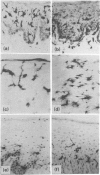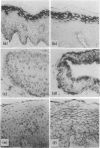Abstract
Human immunodeficiency virus (HIV) is commonly transmitted, during homosexual and heterosexual intercourse, through the rectal and cervicovaginal mucosa, foreskin and urethral epithelia. However, there is uncertainty about HIV transmission through the oral mucosa by oral sex. We have carried out a comparative immunohistological investigation of primate oral, cervicovaginal, foreskin, urethral and rectal epithelia for potential HIV receptors. We investigated epithelial tissues for CD4 glycoprotein, which is the principal receptor for HIV, Fc receptors of IgG for binding HIV-IgG antibody complexes, and HLA class II, which might enable HIV-bound CD4+ cells to gain access to the epithelial cells. CD4 glycoprotein was not found in oral, foreskin, urethral, vaginal or rectal epithelial cells, although CD4+ mononuclear cells were present in the lamina propria of each epithelium. Fc gamma II and Fc gamma III receptors were found in urethral, endocervical and rectal epithelia, and Fc gamma III and Fc gamma I receptors in the foreskin. However, Fc gamma receptors were not found in oral epithelium (buccal, labial, lingual or palatal) and only Fc gamma III receptors were detected in the gingival epithelial cells. HLA class II antigen was also not detected in foreskin, oral or rectal epithelium, but it was expressed by endocervical cells from most human specimens and in male urethral epithelia of non-human male primates. Langerhans' cells were found in all epithelia except those of the urethra and rectum, and they can express CD4 glycoprotein, Fc gamma receptors and HLA class II antigen. The mean number of Langerhans' cells expressing CD4 in the upper third of oral epithelium was significantly lower compared with vaginal epithelium or foreskin. The HIV-binding V1 domain of CD4 was significantly decreased in Langerhans' cells present in oral compared with vaginal epithelium. The results suggest that the foreskin in uncircumcised men and the cervicovaginal epithelium in females might become infected via the CD4+ Langerhans' cells. However, urethral infection might be mediated by HIV-antibody complexes binding to urethral epithelial Fc gamma receptors. The paucity of Langerhans' cells expressing the V1 domain of CD4, the absence of Fc gamma receptors, and a lack of expression of HLA class II antigens in most oral epithelial cells, argue against transmission of HIV through the normal intact oral mucosa.
Full text
PDF
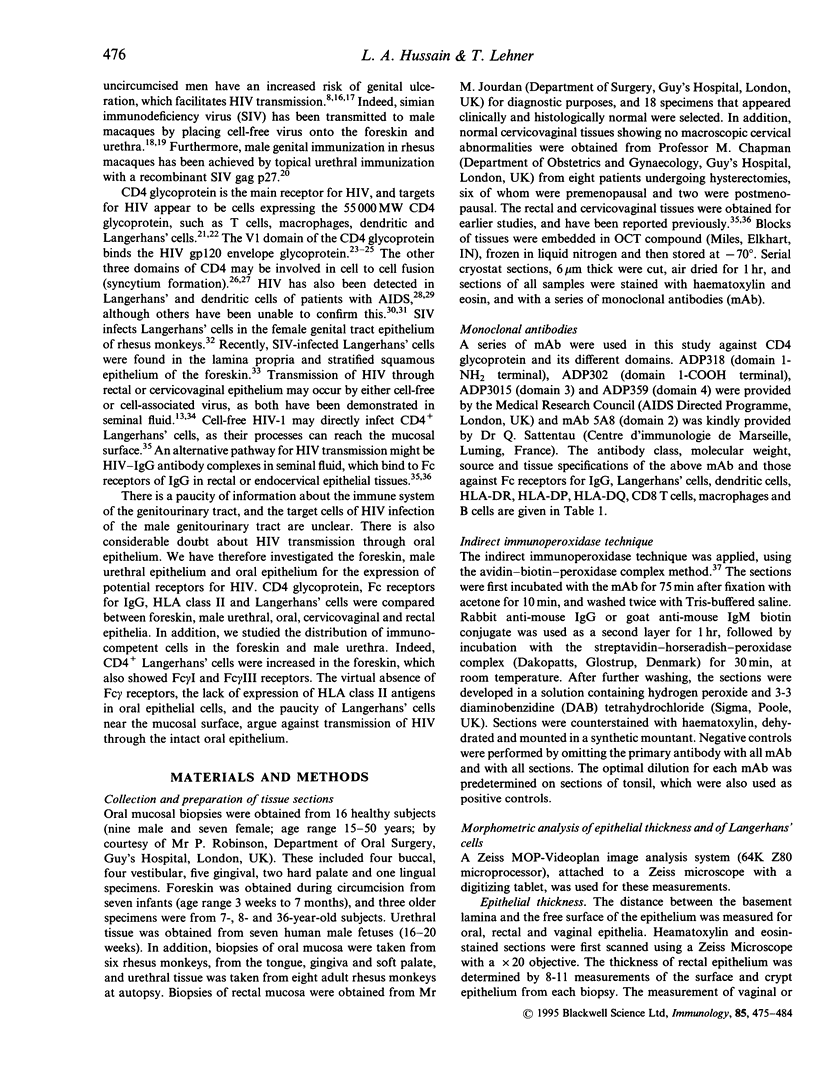




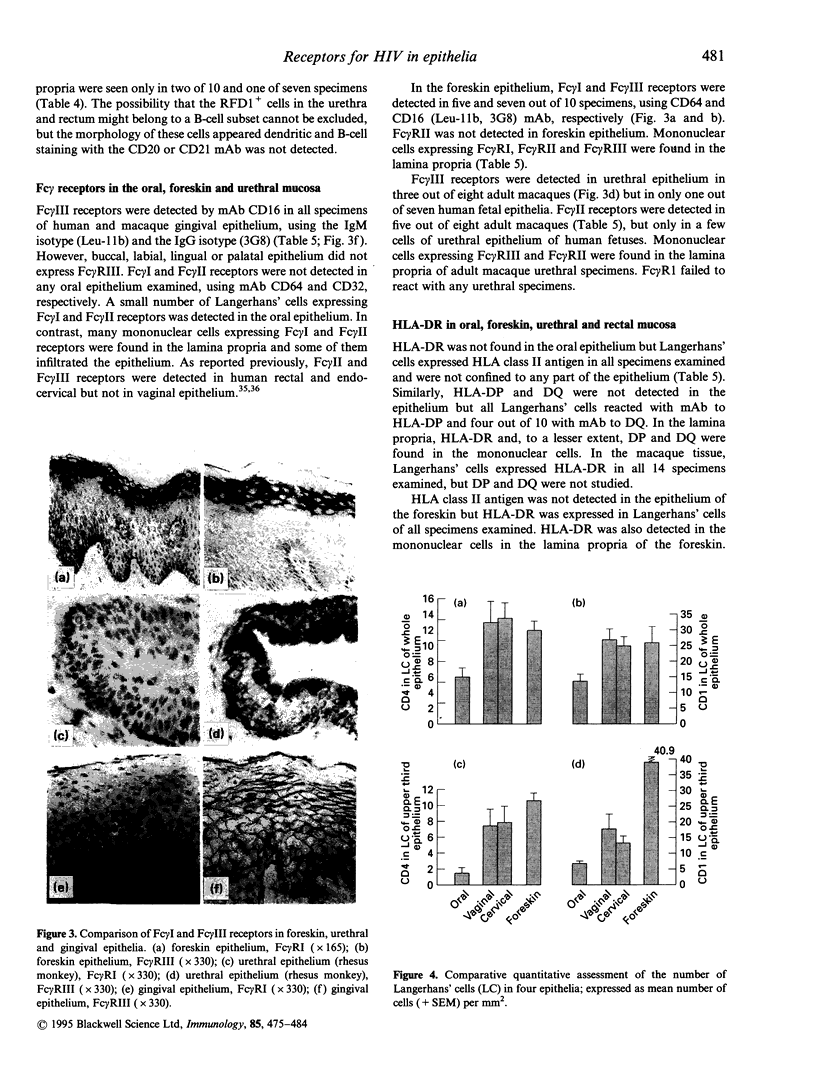


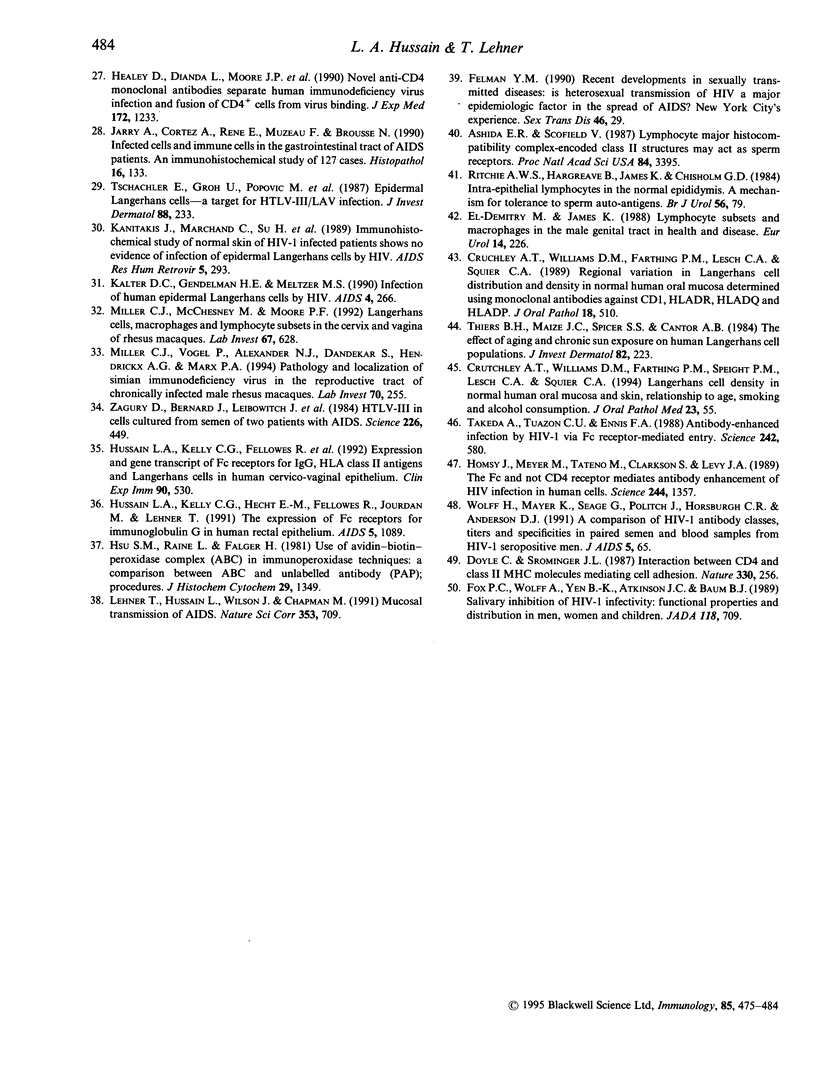
Images in this article
Selected References
These references are in PubMed. This may not be the complete list of references from this article.
- Arthos J., Deen K. C., Chaikin M. A., Fornwald J. A., Sathe G., Sattentau Q. J., Clapham P. R., Weiss R. A., McDougal J. S., Pietropaolo C. Identification of the residues in human CD4 critical for the binding of HIV. Cell. 1989 May 5;57(3):469–481. doi: 10.1016/0092-8674(89)90922-7. [DOI] [PubMed] [Google Scholar]
- Ashida E. R., Scofield V. L. Lymphocyte major histocompatibility complex-encoded class II structures may act as sperm receptors. Proc Natl Acad Sci U S A. 1987 May;84(10):3395–3399. doi: 10.1073/pnas.84.10.3395. [DOI] [PMC free article] [PubMed] [Google Scholar]
- Camerini D., Seed B. A CD4 domain important for HIV-mediated syncytium formation lies outside the virus binding site. Cell. 1990 Mar 9;60(5):747–754. doi: 10.1016/0092-8674(90)90089-w. [DOI] [PubMed] [Google Scholar]
- Cameron D. W., Simonsen J. N., D'Costa L. J., Ronald A. R., Maitha G. M., Gakinya M. N., Cheang M., Ndinya-Achola J. O., Piot P., Brunham R. C. Female to male transmission of human immunodeficiency virus type 1: risk factors for seroconversion in men. Lancet. 1989 Aug 19;2(8660):403–407. doi: 10.1016/s0140-6736(89)90589-8. [DOI] [PubMed] [Google Scholar]
- Chin J. Global estimates of AIDS cases and HIV infections: 1990. AIDS. 1990;4 (Suppl 1):S277–S283. doi: 10.1097/00002030-199001001-00045. [DOI] [PubMed] [Google Scholar]
- Cruchley A. T., Williams D. M., Farthing P. M., Lesch C. A., Squier C. A. Regional variation in Langerhans cell distribution and density in normal human oral mucosa determined using monoclonal antibodies against CD1, HLADR, HLADQ and HLADP. J Oral Pathol Med. 1989 Oct;18(9):510–516. doi: 10.1111/j.1600-0714.1989.tb01353.x. [DOI] [PubMed] [Google Scholar]
- Cruchley A. T., Williams D. M., Farthing P. M., Speight P. M., Lesch C. A., Squier C. A. Langerhans cell density in normal human oral mucosa and skin: relationship to age, smoking and alcohol consumption. J Oral Pathol Med. 1994 Feb;23(2):55–59. doi: 10.1111/j.1600-0714.1994.tb00256.x. [DOI] [PubMed] [Google Scholar]
- Curran J. W., Morgan W. M., Hardy A. M., Jaffe H. W., Darrow W. W., Dowdle W. R. The epidemiology of AIDS: current status and future prospects. Science. 1985 Sep 27;229(4720):1352–1357. doi: 10.1126/science.2994217. [DOI] [PubMed] [Google Scholar]
- Dalgleish A. G., Beverley P. C., Clapham P. R., Crawford D. H., Greaves M. F., Weiss R. A. The CD4 (T4) antigen is an essential component of the receptor for the AIDS retrovirus. Nature. 1984 Dec 20;312(5996):763–767. doi: 10.1038/312763a0. [DOI] [PubMed] [Google Scholar]
- DeGruttola V., Mayer K. H. Human immunodeficiency virus and oral intercourse. Ann Intern Med. 1987 Sep;107(3):428–429. doi: 10.7326/0003-4819-107-2-428_2. [DOI] [PubMed] [Google Scholar]
- Doyle C., Strominger J. L. Interaction between CD4 and class II MHC molecules mediates cell adhesion. Nature. 1987 Nov 19;330(6145):256–259. doi: 10.1038/330256a0. [DOI] [PubMed] [Google Scholar]
- Felman Y. M. Recent developments in sexually transmitted diseases: is heterosexual transmission of HIV a major epidemiologic factor in the spread of AIDS? New York City's experience. Cutis. 1990 Jul;46(1):29–31. [PubMed] [Google Scholar]
- Fox P. C., Wolff A., Yeh C. K., Atkinson J. C., Baum B. J. Salivary inhibition of HIV-1 infectivity: functional properties and distribution in men, women, and children. J Am Dent Assoc. 1989 Jun;118(6):709–711. doi: 10.14219/jada.archive.1989.0165. [DOI] [PubMed] [Google Scholar]
- Healey D., Dianda L., Moore J. P., McDougal J. S., Moore M. J., Estess P., Buck D., Kwong P. D., Beverley P. C., Sattentau Q. J. Novel anti-CD4 monoclonal antibodies separate human immunodeficiency virus infection and fusion of CD4+ cells from virus binding. J Exp Med. 1990 Oct 1;172(4):1233–1242. doi: 10.1084/jem.172.4.1233. [DOI] [PMC free article] [PubMed] [Google Scholar]
- Ho D. D., Byington R. E., Schooley R. T., Flynn T., Rota T. R., Hirsch M. S. Infrequency of isolation of HTLV-III virus from saliva in AIDS. N Engl J Med. 1985 Dec 19;313(25):1606–1606. doi: 10.1056/NEJM198512193132512. [DOI] [PubMed] [Google Scholar]
- Homsy J., Meyer M., Tateno M., Clarkson S., Levy J. A. The Fc and not CD4 receptor mediates antibody enhancement of HIV infection in human cells. Science. 1989 Jun 16;244(4910):1357–1360. doi: 10.1126/science.2786647. [DOI] [PubMed] [Google Scholar]
- Hussain L. A., Kelly C. G., Fellowes R., Hecht E. M., Wilson J., Chapman M., Lehner T. Expression and gene transcript of Fc receptors for IgG, HLA class II antigens and Langerhans cells in human cervico-vaginal epithelium. Clin Exp Immunol. 1992 Dec;90(3):530–538. doi: 10.1111/j.1365-2249.1992.tb05878.x. [DOI] [PMC free article] [PubMed] [Google Scholar]
- Hussain L. A., Kelly C. G., Hecht E. M., Fellowes R., Jourdan M., Lehner T. The expression of Fc receptors for immunoglobulin G in human rectal epithelium. AIDS. 1991 Sep;5(9):1089–1094. doi: 10.1097/00002030-199109000-00004. [DOI] [PubMed] [Google Scholar]
- Jarry A., Cortez A., René E., Muzeau F., Brousse N. Infected cells and immune cells in the gastrointestinal tract of AIDS patients. An immunohistochemical study of 127 cases. Histopathology. 1990 Feb;16(2):133–140. doi: 10.1111/j.1365-2559.1990.tb01081.x. [DOI] [PubMed] [Google Scholar]
- Kanitakis J., Marchand C., Su H., Thivolet J., Zambruno G., Schmitt D., Gazzolo L. Immunohistochemical study of normal skin of HIV-1-infected patients shows no evidence of infection of epidermal Langerhans cells by HIV. AIDS Res Hum Retroviruses. 1989 Jun;5(3):293–302. doi: 10.1089/aid.1989.5.293. [DOI] [PubMed] [Google Scholar]
- Kanitakis J., Thivolet J. Infection of human epidermal Langerhans' cells by HIV. AIDS. 1990 Mar;4(3):266–268. [PubMed] [Google Scholar]
- Klatzmann D., Champagne E., Chamaret S., Gruest J., Guetard D., Hercend T., Gluckman J. C., Montagnier L. T-lymphocyte T4 molecule behaves as the receptor for human retrovirus LAV. Nature. 1984 Dec 20;312(5996):767–768. doi: 10.1038/312767a0. [DOI] [PubMed] [Google Scholar]
- Kreiss J. K., Hopkins S. G. The association between circumcision status and human immunodeficiency virus infection among homosexual men. J Infect Dis. 1993 Dec;168(6):1404–1408. doi: 10.1093/infdis/168.6.1404. [DOI] [PubMed] [Google Scholar]
- Lehner T., Hussain L., Wilson J., Chapman M. Mucosal transmission of HIV. Nature. 1991 Oct 24;353(6346):709–709. doi: 10.1038/353709c0. [DOI] [PubMed] [Google Scholar]
- Lehner T., Tao L., Panagiotidi C., Klavinskis L. S., Brookes R., Hussain L., Meyers N., Adams S. E., Gearing A. J., Bergmeier L. A. Mucosal model of genital immunization in male rhesus macaques with a recombinant simian immunodeficiency virus p27 antigen. J Virol. 1994 Mar;68(3):1624–1632. doi: 10.1128/jvi.68.3.1624-1632.1994. [DOI] [PMC free article] [PubMed] [Google Scholar]
- Maddon P. J., Molineaux S. M., Maddon D. E., Zimmerman K. A., Godfrey M., Alt F. W., Chess L., Axel R. Structure and expression of the human and mouse T4 genes. Proc Natl Acad Sci U S A. 1987 Dec;84(24):9155–9159. doi: 10.1073/pnas.84.24.9155. [DOI] [PMC free article] [PubMed] [Google Scholar]
- Mayer K. H., Ayotte D., Groopman J. E., Stoddard A. M., Sarngadharan M., Gallo R. Association of human T lymphotropic virus type III antibodies with sexual and other behaviors in a cohort of homosexual men from Boston with and without generalized lymphadenopathy. Am J Med. 1986 Mar;80(3):357–363. doi: 10.1016/0002-9343(86)90706-0. [DOI] [PubMed] [Google Scholar]
- Miller C. J., Alexander N. J., Sutjipto S., Joye S. M., Hendrickx A. G., Jennings M., Marx P. A. Effect of virus dose and nonoxynol-9 on the genital transmission of SIV in rhesus macaques. J Med Primatol. 1990;19(3-4):401–409. [PubMed] [Google Scholar]
- Miller C. J., Alexander N. J., Sutjipto S., Lackner A. A., Gettie A., Hendrickx A. G., Lowenstine L. J., Jennings M., Marx P. A. Genital mucosal transmission of simian immunodeficiency virus: animal model for heterosexual transmission of human immunodeficiency virus. J Virol. 1989 Oct;63(10):4277–4284. doi: 10.1128/jvi.63.10.4277-4284.1989. [DOI] [PMC free article] [PubMed] [Google Scholar]
- Miller C. J., McChesney M., Moore P. F. Langerhans cells, macrophages and lymphocyte subsets in the cervix and vagina of rhesus macaques. Lab Invest. 1992 Nov;67(5):628–634. [PubMed] [Google Scholar]
- Miller C. J., Vogel P., Alexander N. J., Dandekar S., Hendrickx A. G., Marx P. A. Pathology and localization of simian immunodeficiency virus in the reproductive tract of chronically infected male rhesus macaques. Lab Invest. 1994 Feb;70(2):255–262. [PubMed] [Google Scholar]
- Parker S. W., Stewart A. J., Wren M. N., Gollow M. M., Straton J. A. Circumcision and sexually transmissible disease. Med J Aust. 1983 Sep 17;2(6):288–290. doi: 10.5694/j.1326-5377.1983.tb122467.x. [DOI] [PubMed] [Google Scholar]
- Peterson A., Seed B. Genetic analysis of monoclonal antibody and HIV binding sites on the human lymphocyte antigen CD4. Cell. 1988 Jul 1;54(1):65–72. doi: 10.1016/0092-8674(88)90180-8. [DOI] [PubMed] [Google Scholar]
- Ritchie A. W., Hargreave T. B., James K., Chisholm G. D. Intra-epithelial lymphocytes in the normal epididymis. A mechanism for tolerance to sperm auto-antigens? Br J Urol. 1984 Feb;56(1):79–83. doi: 10.1111/j.1464-410x.1984.tb07169.x. [DOI] [PubMed] [Google Scholar]
- Simonsen J. N., Cameron D. W., Gakinya M. N., Ndinya-Achola J. O., D'Costa L. J., Karasira P., Cheang M., Ronald A. R., Piot P., Plummer F. A. Human immunodeficiency virus infection among men with sexually transmitted diseases. Experience from a center in Africa. N Engl J Med. 1988 Aug 4;319(5):274–278. doi: 10.1056/NEJM198808043190504. [DOI] [PubMed] [Google Scholar]
- Takeda A., Tuazon C. U., Ennis F. A. Antibody-enhanced infection by HIV-1 via Fc receptor-mediated entry. Science. 1988 Oct 28;242(4878):580–583. doi: 10.1126/science.2972065. [DOI] [PubMed] [Google Scholar]
- Taylor P. K., Rodin P. Herpes genitalis and circumcision. Br J Vener Dis. 1975 Aug;51(4):274–277. doi: 10.1136/sti.51.4.274. [DOI] [PMC free article] [PubMed] [Google Scholar]
- Thiers B. H., Maize J. C., Spicer S. S., Cantor A. B. The effect of aging and chronic sun exposure on human Langerhans cell populations. J Invest Dermatol. 1984 Mar;82(3):223–226. doi: 10.1111/1523-1747.ep12260055. [DOI] [PubMed] [Google Scholar]
- Tschachler E., Groh V., Popovic M., Mann D. L., Konrad K., Safai B., Eron L., diMarzo Veronese F., Wolff K., Stingl G. Epidermal Langerhans cells--a target for HTLV-III/LAV infection. J Invest Dermatol. 1987 Feb;88(2):233–237. doi: 10.1111/1523-1747.ep12525402. [DOI] [PubMed] [Google Scholar]
- Van Voorhis B. J., Martinez A., Mayer K., Anderson D. J. Detection of human immunodeficiency virus type 1 in semen from seropositive men using culture and polymerase chain reaction deoxyribonucleic acid amplification techniques. Fertil Steril. 1991 Mar;55(3):588–594. [PubMed] [Google Scholar]
- Vogt M. W., Witt D. J., Craven D. E., Byington R., Crawford D. F., Schooley R. T., Hirsch M. S. Isolation of HTLV-III/LAV from cervical secretions of women at risk for AIDS. Lancet. 1986 Mar 8;1(8480):525–527. doi: 10.1016/s0140-6736(86)90884-6. [DOI] [PubMed] [Google Scholar]
- Winkelstein W., Jr, Lyman D. M., Padian N., Grant R., Samuel M., Wiley J. A., Anderson R. E., Lang W., Riggs J., Levy J. A. Sexual practices and risk of infection by the human immunodeficiency virus. The San Francisco Men's Health Study. JAMA. 1987 Jan 16;257(3):321–325. [PubMed] [Google Scholar]
- Winkelstein W., Jr, Wiley J. A., Padian N., Levy J. Potential for transmission of AIDS-associated retrovirus from bisexual men in San Francisco to their female sexual contacts. JAMA. 1986 Feb 21;255(7):901–901. [PubMed] [Google Scholar]
- Wolff H., Mayer K., Seage G., Politch J., Horsburgh C. R., Anderson D. A comparison of HIV-1 antibody classes, titers, and specificities in paired semen and blood samples from HIV-1 seropositive men. J Acquir Immune Defic Syndr. 1992;5(1):65–69. [PubMed] [Google Scholar]
- Zagury D., Bernard J., Leibowitch J., Safai B., Groopman J. E., Feldman M., Sarngadharan M. G., Gallo R. C. HTLV-III in cells cultured from semen of two patients with AIDS. Science. 1984 Oct 26;226(4673):449–451. doi: 10.1126/science.6208607. [DOI] [PubMed] [Google Scholar]
- el-Demiry M., James K. Lymphocyte subsets and macrophages in the male genital tract in health and disease. A monoclonal antibody-based study. Eur Urol. 1988;14(3):226–235. doi: 10.1159/000472944. [DOI] [PubMed] [Google Scholar]




